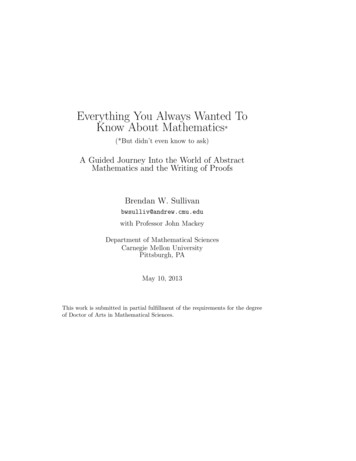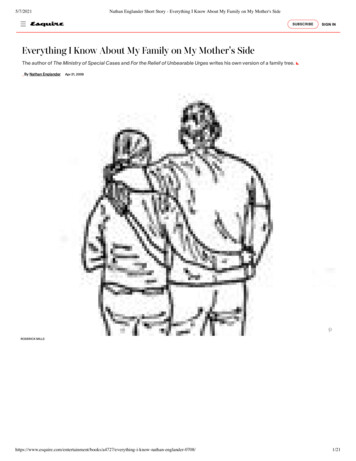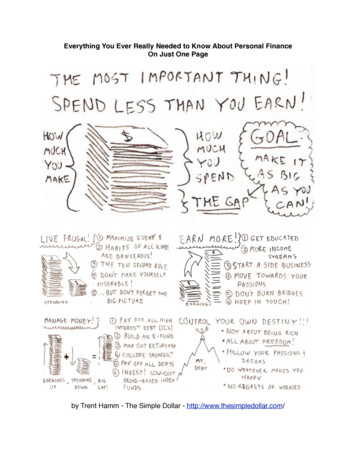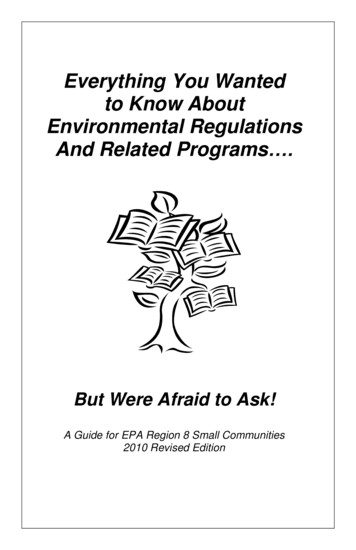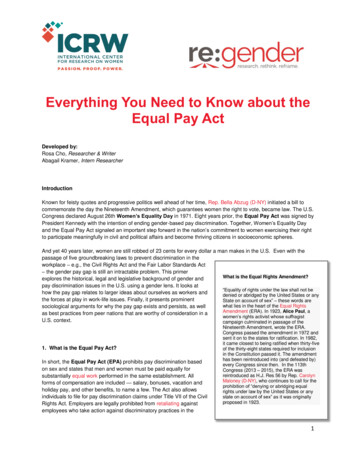
Transcription
Everything You Need to Know about theEqual Pay ActDeveloped by:Rosa Cho, Researcher & WriterAbagail Kramer, Intern ResearcherIntroductionKnown for feisty quotes and progressive politics well ahead of her time, Rep. Bella Abzug (D-NY) initiated a bill tocommemorate the day the Nineteenth Amendment, which guarantees women the right to vote, became law. The U.S.Congress declared August 26th Women’s Equality Day in 1971. Eight years prior, the Equal Pay Act was signed byPresident Kennedy with the intention of ending gender-based pay discrimination. Together, Women’s Equality Dayand the Equal Pay Act signaled an important step forward in the nation’s commitment to women exercising their rightto participate meaningfully in civil and political affairs and become thriving citizens in socioeconomic spheres.And yet 40 years later, women are still robbed of 23 cents for every dollar a man makes in the U.S. Even with thepassage of five groundbreaking laws to prevent discrimination in theworkplace – e.g., the Civil Rights Act and the Fair Labor Standards Act– the gender pay gap is still an intractable problem. This primerWhat is the Equal Rights Amendment?explores the historical, legal and legislative background of gender andpay discrimination issues in the U.S. using a gender lens. It looks at“Equality of rights under the law shall not behow the pay gap relates to larger ideas about ourselves as workers anddenied or abridged by the United States or anythe forces at play in work-life issues. Finally, it presents prominentState on account of sex” – these words arewhat lies in the heart of the Equal Rightssociological arguments for why the pay gap exists and persists, as wellAmendment (ERA). In 1923, Alice Paul, aas best practices from peer nations that are worthy of consideration in awomen’s rights activist whose suffragistU.S. context.campaign culminated in passage of the1. What is the Equal Pay Act?In short, the Equal Pay Act (EPA) prohibits pay discrimination basedon sex and states that men and women must be paid equally forsubstantially equal work performed in the same establishment. Allforms of compensation are included — salary, bonuses, vacation andholiday pay, and other benefits, to name a few. The Act also allowsindividuals to file for pay discrimination claims under Title VII of the CivilRights Act. Employers are legally prohibited from retaliating againstemployees who take action against discriminatory practices in theNineteenth Amendment, wrote the ERA.Congress passed the amendment in 1972 andsent it on to the states for ratification. In 1982,it came closest to being ratified when thirty-fiveof the thirty-eight states required for inclusionin the Constitution passed it. The amendmenthas been reintroduced into (and defeated by)every Congress since then. In the 113thCongress (2013 – 2015), the ERA wasreintroduced as H.J. Res 56 by Rep. CarolynMaloney (D-NY), who continues to call for theprohibition of “denying or abridging equalrights under law by the United States or anystate on account of sex” as it was originallyproposed in 1923.1
Everything You Need to Know about the Equal Pay Actworkplace. However, the law allows for pay differentials when individuals are evaluated based on criteria such asseniority, production levels, and merit. Administered and enforced by the U.S. Equal Employment OpportunityCommission (EEOC), the EPA was signed into law in 1963 as part of the Fair Labor Standards Act of 1938. Itsemployee protections and prohibitions against discrimination align it with other federal laws such as Title VII of theCivil Rights Act of 1964, the Age Discrimination in Employment Act (ADEA) of 1967, and Title I of the Americans withDisabilities Act (ADA) of 1990.2. History & timelineAlthough many women – women of color, immigrant women and poor and working class women, to name a few –have worked outside the home or been paid for their labor since the country’s beginning, the world of paid work hasprimarily existed as part of men’s “public” sphere in the American psyche. Up until WWII when unprecedentednumbers of women entered the workforce, women were expected to exist in the “private” sphere, performing unpaidwork. Recognizing that women largely replaced male workers in war labor industry, the National War Labor Board in1942 encouraged industry leaders to make “adjustments which [would] equalize wage or salary rates paid to femaleswith the rates paid to males for comparable quality and quantity of work on the same or similar operation.”More and more women entered the world of paid labor thereafter, and pay discrimination based on sex remainedrampant and blatant. Women made 59% of what men earned in 1963. In the early 1960s, job advertisements werelisted by sex. Not surprisingly, most high-salary positions were allocated to men, and even when the sameposition was advertised to both sexes, a two-tiered scale ensured male candidates would be paid more than theirfemale counterparts.Rep. Winifred Stanley (R-NY) proposed the first bill to amend the National Labor Relations Act to end gender wagediscrimination in 1944, but the bill expired after it was referred to the Committee on Labor. In 1950, Rep. Katharine St.George (R-NY), renowned for coining the phrase “equal pay for equal work,” negotiated a compromise bill that wouldalso permit the passage of the Equal Rights Amendment. This bill also failed. Ever persistent, St. George proposed awork bill in 1959 that called for equal pay for comparable work. It stalled for considerable time because of debatesover the definition of “comparable.” As St. George remarked in an oral history interview: “I always felt women werediscriminated against in employment I think women are quite capable of holding their own if they’re given theopportunity. What I wanted them to have was the opportunity.”The bill’s language held up and ultimately became part of the EPA. On June 10, 1963, President John F. Kennedysigned the Equal Pay Act, and the law took effect on June 11, 1964 as part of Kennedy’s New Frontier Program.TIMELINEDateStatusDecember 10, 1923First introducedAugust 1, 2013ReintroducedLegislationEqual Rights Amendment: “Equality of rights under the law shallnot be denied or abridged by the United States or any State onaccount of sex” – these words are the heart of the Equal RightsAmendment (ERA). In 1923, Alice Paul, a women’s rights activistwhose suffragist campaign culminated in passage of the NineteenthAmendment, wrote the ERA. Congress passed the amendment in1972 and sent it on to the states for ratification. In 1982, it cameclosest to being ratified when thirty-five of the thirty-eight statesrequired for inclusion in the Constitution passed it. The amendmenthas been reintroduced into (and defeated by) every Congress sincethen. In the 113th Congress (2013 – 2015), the ERA was2
Everything You Need to Know about the Equal Pay Actreintroduced as H.J. Res 56 by Rep. Carolyn Maloney (D-NY), whocontinues to call for the prohibition of “denying or abridging equalrights under law by the United States or any State on account of sex”as it was originally proposed in 1923.June 25, 1938June 10, 1963July 2, 1964December 15, 1967EnactedFair Labor Standards Act: On June 25, 1938, the Fair LaborStandards Act (FLSA) was signed into law by President Franklin D.Roosevelt. Designed to eliminate “labor conditions detrimental to themaintenance of the minimum standards of living necessary forhealth, efficiency, and general well-being of workers,” the FLSA wasthe last piece of New Deal legislation passed. It establishes minimumwage, overtime pay, recordkeeping and child labor standards. Thelaw impacts full-time and part-time workers of both private andFederal, State and local government sectors. It is administered andenforced by the Wage and Hour Division of the U.S. Department ofLabor.EnactedEqual Pay Act: On June 10, 1963, President Kennedy signed theEqual Pay Act, as part of the Fair Labor Standards Act, into law.The EPA“prohibits sex-based wage discrimination between men andwomen in the same establishment who perform jobs that requiresubstantially equal skill, effort and responsibility under similarworking conditions.” Administered and enforced by the EqualEmployment Opportunity Commission (EEOC), the EPA attempts tofulfill the aspiration of equal pay for equal work and reduce thegender pay gap.EnactedTitle VII of the Civil Rights Act: On July, 2, 1964, the Civil RightsAct, originally proposed by President John F. Kennedy, was signedinto law by President Lyndon B. Johnson. Enforced by the EqualEmployment Opportunity Commission (EEOC), Title VII of the CivilRights Act of 1964 prohibits employment discrimination based oncolor, race, sex, religion and national origin in workplaces havingmore than 15 employees, including local, State and Federalgovernment offices, employment agencies and labor organizations.The law covers job applications, hiring procedures, job training andterms, conditions, and privileges of employment. It prohibitsemployment decisions based on stereotypes and otherdiscriminatory practices – not only intentional discrimination but alsoneutral employment policies that have disproportionately negativeor disparate impact on individuals of certain racial/ethnic groups.EnactedAge Discrimination in Employment Act (ADEA): On December15, 1967, the Age Discrimination in Employment Act (ADEA) wassigned into law by President Lyndon B. Johnson. The ADEAprohibits employment discrimination against workers 40-years old orolder and affects various employment-related issues, ranging fromjob application, hiring procedures, job training to terms, conditions,and privileges of employment, etc. Enforced by the EqualEmployment Opportunity Commission (EEOC), the law applies toemployers with 20 or more employees and to federal government,interstate agencies, employment agencies and labor unions.3
Everything You Need to Know about the Equal Pay ActEnactedTitle IX of the Education Amendments: On June 23, 1972, Title IXof the Education Amendments was signed into law by PresidentRichard Nixon and it added strength to the women’s rightsmovement. Commonly known for prohibiting sex discrimination inathletic activities in schools, Title IX applies to other areas ofeducation that receive federal funding, including higher education,career education, programs related to standardized testing andemployment, etc.EnactedTitle I of the Americans with Disabilities Act (ADA): On July 26,1990, the Americans with Disabilities Act (ADA) was signed into lawby President George H. W. Bush. The ADA prohibits discriminationbased on disability, and specifically, Title I of the ADA prohibits arange of employment-related discriminatory issues, ranging from jobapplication, hiring procedures, job training to terms and conditions ofemployment, etc. Various employers with 15 or more employees private and public sector employers, employment agencies and laborunions – must comply with this law. The ADA is enforced by severalFederal agencies, including the Equal Employment OpportunityCommission (EEOC) for the employment-associated provisions.Re-introducedPaycheck Fairness Act: On April 20, 2005, Sen. Hilary Clinton (DNY), Rep. Rosa DeLauro (D-CT) and Sen. Tom Daschle (D-SD)proposed the Paycheck Fairness Act. Its purpose: to increase thepenalties for equal pay violations and to prohibit retaliation againstwhistle-blowers. This bill has experienced a number of turbulentmoments since its inception. Of recent developments, the Housepassed the Paycheck Fairness Act with large bipartisan support inJanuary 2009, but in June 2012, it failed to move forward due to aprocedural vote on the Senate floor. On January 23, 2013, it wasreintroduced by Sen. Barbara Mikulski (D-MD) and Rep. RosaDeLauro (D-CT). The proposed bill seeks to amend the Equal PayAct and to revise the current remedies, enforcements and exceptionsto violations of the prohibitions against sex discrimination in thepayment of wages. In addition, the Act calls for a study of datacollected by the Equal Employment Opportunity Commission(EEOC) and proposes voluntary guidelines to show employers howto evaluate jobs with the goal of eliminating inequalities.January 29, 2009EnactedLilly Ledbetter Fair Pay Act: On January 29, 2009, PresidentObama signed the Lilly Ledbetter Fair Pay Act into law. The Act wasconstructed after its namesake endured discrimination for years butwas unaware of it until long after she retired because her formeremployee prohibited employees from sharing or discussinginformation on their wages. The Act removes the statute of limitationon filing for gender pay discrimination to EEOC, which was originallystipulated as 180 days after receiving a paycheck based on genderpay inequal.June 20, 2012Not put to a voteEqual Employment Opportunity Restoration Act: The EqualEmployment Opportunity Restoration Act of 2012 (EEORA) wasintroduced in the House and the Senate on June 20, 2012. TheJune 23, 1972July 26, 1990April 20, 20054
Everything You Need to Know about the Equal Pay ActEEORA sought to restore employees’ ability to challengediscriminatory employment practices as a group. This was in reactionto the 5-4 Supreme Court decision in Wal-Mart Stores, Inc. v. Dukes,which allowed Wal-Mart's efforts to obstruct employees' ability tomount class action lawsuits against the company. The bill wassponsored by Rep. Rosa DeLauro (D-CT) and Sen. Alan Franken(D-MN).January 28, 2013March 5, 2013June 4, 2013ReintroducedFair Pay Act: The Fair Pay Act of 2013 was introduced in the Houseon January 28, 2013 and in the Senate on January 29, 2013. TheAct seeks to end wage discrimination against those who work infemale- or minority-dominated jobs by establishing equal pay forequivalent work; it prohibits wage discrimination based on sex, race,or national origin. The Fair Pay Act makes exceptions for differentwages based on seniority, merit, or quantity/quality of work andcontains an exemption for small businesses. The bill is sponsored byRep. Eleanor Norton (D-DC) and Sen. Thomas Harkin (D-IA).Referred toCommitteeFair Minimum Wage Act: The Fair Minimum Wage Act of 2013 wasintroduced in the House on March 6, 2013 and in the Senate onMarch 5, 2013. The Act seeks to increase the Federal minimumwage for employees to 8.20 per hour; after one year it would rise to 9.15 per hour, then to 10.10 per hour after two years. Thereafter,the increase would be an amount based on increases in theConsumer Price Index (CPI) annually. The bill is sponsored by Sen.Tom Harkin (D-Iowa) and Rep. George Miller (D-CA).Not passed by NYState SenateNew York Women’s Equality Act: In New York state, the Women’sEquality Coalition - representing the Equal Pay Coalition NYC, NewYork Women’s Agenda, and New York State Pay Equity Coalition initiated the Women’s Equality Act, which was supported andreleased by Governor Cuomo on June 4, 2013. The bill, comprisedof 10 sections, promoted gender pay equity and sought an end todiscrimination based on family status or pregnancy, among others.On June 21, 2013, the NY State Assembly passed the entireWomen’s Equality Act omnibus bill. However, the NY State Senatedid not pass the reproductive health protection section, although itpassed all the other sections.3. Why the EPA is relevant todayIn 2013, the gender pay gap (unadjusted), or “a measure of unequal pay for women compared to men,” is stillprevalent and persistent in the U.S. When the EPA was signed in 1963, women earned on average 59% of what menwere paid – that is, 59 cents for every dollar men made. Fast forward 50 years: women earn on average 77% of whatmen are paid, or 77 cents for every dollar men make. That is an increase of less than 4 cents per decade. A recentanalysis by the Institute for Women’s Policy Research on the trajectory of the gender pay gap from 1960-2012 is an5
Everything You Need to Know about the Equal Pay Actexcellent illustration of how progress in shrinking the gap has stalled since 2002. While many blatantly sexistdiscriminatory practices in the workplace might have dissipated or transmutated over the years, unequal pay has not.The gender pay gap affects all women, though it has never affected all women equally. According to a study thatcompared cross-racial/ethnic gender pay differentials in 2012, the median weekly earnings of women of allracial/ethnic groups were less than that of their male counterparts: 12% less among Hispanic or Latino/a, 10% lessamong African Americans, 19% less among Whites, and 27% less among Asian Americans. The median weeklywages of white men are higher than all others, as can be seen in this chart.Women’s earnings as a percentage ofearnings by men of same race/ethnicityWomen’s earnings as a percentage ofwhite men’s earningsHispanic or Latina88%59%African American90%68%White81%81%Asian American73%88%4. Measuring the pay gapThere are different methods, but the basic idea is to calculate the difference between men’s and women’s typicalearnings and to report the difference in relation to men’s earnings, i.e., the highest earnings.Median earnings are used to calculate the difference because they represent the middle value of earnings of allworkers across the whole economy.Pay Gap (Men’s median earnings – Women’s median earnings) / Men’s median earningsFor example, according to the Census Bureau and the Bureau of Labor Statistics, men’s median annual earnings in2011 was 48,202 and women’s median annual earnings was 37,118. The 2011 gender pay gap: ( 48,202 37,118) / 48,202 23%.Earnings ratios can be used to express the same idea. The earnings ratio is calculated by dividing women’s medianearnings by men’s median earnings.Earnings Ratio Women’s median earnings / Men’s median earnings6
Everything You Need to Know about the Equal Pay ActThe earnings ratio in 2011: 37,118 / 48,202 77%.Economists use different earnings measurements such as hourly, weekly or annual wages. Some observe long-termpatterns, using data from various points in history. Others focus on what they call “adjusted” pay gaps, that is, the paygap after factoring in and adjusting for individual characteristics such as age, gender, family size, education level, jobexperience, and industry, among other variables. In the U.S., these adjusted figures tend to narrow the gender paygap. For example, according to one study, researchers found that after adjusting for those individual characteristics,the gender pay gap was 19%, and when they additionally controlled for industries and occupations, the gap became9%.5. Why is there a gap?What more can be gleaned from looking at the pay gap? One major fact is the highly “gendered” look of ourworkplace, also known as occupational segregation. Men (approximately 49%) work in industries predominantlyoccupied by men, and women (41%) work in industries predominantly occupied by women. Male-dominatedindustries tend to offer more better-paid positions versus more poorly paid positions in female-dominated industries –a phenomenon observed by some as a “jobs gap.”Regardless of which gender dominates the industry, across almost all occupations men’s earnings are higher thanwomen’s. The following analysis is based on a 2011 study by the Institute for Women’s Policy Research. Women arehighly visible in two occupational categories of secretaries and administrative assistants and receptionists andinformation clerks, occupying 96% and 93% of the workforce, respectively. But a gender pay gap of 9.4% adheresamong secretaries and administrative assistants and 3.3% among receptionists and information clerks. Bigger wagegaps occur in occupations that could be stepping stones to better-paid, management positions, such as first-linesupervisors/managers of retail sales workers or accountants and auditors. Female first-line supervisors/managersmade 74% of what their male peers made, and female accountants/auditors made 75% of what their male peersmade.Percentage of femaleworkers in occupation(%)Women’s earnings asa percentage of whitemen’s earnings (%)Gender pay gap (%)Secretaries and administrativeassistants95.790.69.4Receptionists and informationclerks92.596.73.3Registered nurses90.586.513.5Common Occupationsfor Women7
Everything You Need to Know about the Equal Pay ActNursing, psychiatric and homehealth aides87.087.512.5Accountants and auditors59.174.925.1First-line supervisors/managersof retail sales workers45.573.926.1The biggest gender pay gap appears in high-paying occupations. For example, female personal financial advisors’median weekly earnings are 962, whereas the same figure for their male counterparts is 1,647, a 41.6% gap. Thepay gap for female medical and legal professionals and chief executives hovers between 23% (chief executives) and29% (physicians/surgeons) despite great inroads in these traditionally male-dominated industries. Among low-payingoccupations, the gender pay gap tends to be smaller. Women still make less than men, however, with the soleexception of the combined food preparation and serving workers, including fast food occupational category.Percentage of femaleworkers in occupation(%)Women’s earning aspercentage of men’s(%)Gender pay gap (%)Physicians and surgeons31.271.029.0Chief executives25.672.127.9Lawyers35.077.122.9Personal financial advisors32.858.441.6Combined food preparation andserving workers, including fastfood60.3112.1- 12.1Highest paying occupations forwomen8
Everything You Need to Know about the Equal Pay ActTraditionally, economists consider two theories to explain the gender pay gap. The first, human capital theory, putsthe emphasis on women’s choices to explain why their pay is less than men’s pay. It hypothesizes that individualcharacteristics or qualifications – e.g., age, education, training, work experience and history – are responsible fordifferences in pay between all workers. This theory says that some workers are paid less because, for example, theylack the needed level of education, training or work experience compared to their competitors. The theory furthersuggests that women’s wages tend to be lower because they choose to work fewer hours due to family and childcareresponsibilities, choose occupations and industries that offer lower wages but more flexibility or expect their careerpaths to be discontinuous. All those choices lead to women accumulating less human capital; as a result, the theorygoes, women are paid less than men because they do not achieve the qualifications required to assume positions intrue competition with men.The second theory, called the discrimination theory, hypothesizes that prejudicial and discriminatory practices inthe workplace are the main culprits of the pay gap. It suggests that discriminatory practices induce differentialtreatments, which then may lead to biased assessments and expectations on productivity, performance evaluation,and appraisal towards one group of workers over others. Intentional and unintentional discriminatory practices arecommon and are often present at the beginning of the employer/employee relationship, as numerous racial biasstudies show. High-end restaurants in Philadelphia were less reluctant to offer job interviews and make job offers tofemale candidates for wait-staff positions over similarly qualified male candidates, one study revealed. In another,researchers found that when female musicians auditioned for symphony orchestras, their chance of being hired wentup when they auditioned behind a screen, concealing their identity from their interviewers.Scholars’ opinions vary on exactly what proportions of the gender pay gap can be explained by differences in humancapital or discrimination in the labor market, but there is a general consensus that data supports both theories. One2007 study by renown labor economists Francine Blau and Lawrence Kahn explains that about 41% of the genderpay gap (20.3%) was due to “unexplained” sources (e.g., discrimination) and the rest due to individual characteristics(e.g., union status, industry and occupational category, etc.), as the following graph shows.FactorsPay Gap ExplainedLabor force experience10.5Race2.4Occupational category27.4Industry experience21.9Union status3.5Unexplained41.1Educational attainment-6.79
Everything You Need to Know about the Equal Pay Act6. Problem for women: constrained choices in contextThe human capital theory is based on the premise of “compensating wage differentials.” That is, people who valueand need flexibility in work hours or conditions, etc. will choose occupations that offer workplace flexibility, henceexchanging high-wage/low-flexibility work for low-wage/high-flexibility work. In reality, workers who occupy high-paypositions tend to enjoy more flexibility and benefits embedded in their positions, something to which many low-payscale workers do not have access. For instance, while there is no overt motherhood penalty, women who takeadvantage of family-friendly policies – e.g., flexible hours – seem to suffer in the form of slow wage increase andthreat of job loss. The notion of low-wage workers being able to negotiate and choose work conditions freely appearsto fall short on evidence, especially in the context of an industry-level misallocation of workplace flexibility andemployees’ needs.Furthermore, women tend to reap lower returns on their investments made for college and professional degrees.Even when women pursue high-level education and choose high-earning career paths such as medicine, law andbusiness, women still do not fare well compared to men, especially in the long-run. One study looked at the postgraduation gender pay gap among the University of Michigan Law 1972-75 cohort. Initially, the pay gap was small.After 15 years, women made only about 60% of what their male counterparts made. Holding constant various lifestylechoices these classmates made over the years – e.g., lengths of part-time work, years of practicing law, types of lawpracticed, family composition, etc. – researchers still found 13% advantage for male cohort members, not attributableto personal characteristics. In a similar study, researchers found a growing trend in pay difference among newlytrained physicians in New York State: in 1999, male physicians made 3,600 more than comparable femalephysicians, and in 2008, the difference increased to 16,819. In another study, comparing financial costs and benefitsof becoming physicians or physician assistants, researchers found that female primary physicians would have beenfinancially better-off if they had chosen to be physician assistants instead. But the same result did not occur for maleprimary physicians.10
Everything You Need to Know about the Equal Pay ActThe fact that women outclass men when it comes to educational attainment has been well-documented in the U.S.Women are more likely to have a college degree than men (46% vs. 36%) and are highly represented in professionaland graduate degree programs. However, these educational investments do not seem to yield the same level offinancial return for women, reflecting the impenetrability of the “glass ceiling” felt even among the highly-educatedfemale workforce in the U.S. The fact that women of color experience an even greater pay gap adds another layer of“impenetrability.” For example, African American and Latina women’s mobility into upper-tier positions is morestrained than that of white women holding professional and managerial-level positions, as one study showed.Looking at the low-wage end of the spectrum, American workers have been struggling with the growing problem ofprecarious work and job insecurity. Precarious work, defined as “employment that is uncertain, unpredictable, andrisky from the point of view of the worker” impacts both men and women workers, particularly of occupy low-wageoccupations, and their sense of economic insecurity and precarious employment relations has increased even withinan expanding economy.7. The gender pay gap outside the U.S.The gender pay gap is a global phenomenon, and advanced economy countries are no exceptions. Although exactfigures on pay differentials fluctuate depending on which years or measures are studied, there appear to be patternsamong industrialized nations, particularly member states of the Organization for Economic Co-operation andDevelopment (OECD). According to one 2013 OECD report, the range of gender pay gap among the top 25industrialized countries is from 6.1% to 28.7%. Countries such as Spain (6.1%), Poland (6.2%), Hungary (6.4%), NewZealand (6.8%), Norway (8.1%) and Belgium (8.9%) tend to have low percentages of pay differentials between menand women, while Japan (28.7%) and Germany (20.8%) tend to report high figures. Of the latest OECDstatistics available online, the median gender wage gap ranges from 4.2% (New Zealand) to 37.5% (South Korea).The U.S.’s figure is 17.8% which is higher than the OECD average of 15.0%.Contextually, the U.S. is notorious for having poor workplace policies compared to other industrialized nations. Itspolicies on parental leave, sick leave, vacations, and other social programs such as childcare are consideredsubstandard and ungenerous by many scholars who study comparative, international social policies. According toresearchers investigating longitudinal data sets from the World Economic Forum’s high-income economies, the U.S.is the only country among its peer nations that does not have a nationwide program for paid leave for new parents orguarantee paid leave for new mothers – with the exception of the states of California, Washington, and New Jersey,which have state-level programs for paid family leave. Nor is there a federal-level policy on paid leave for personalillness or to address family members’ illness. Most advanced-economy countries offer work-family friendly policiessuch as paid leave for new parents, paid leave to take care of children’s health issues, breastfeeding breaks, and aweek
1 Everything You Need to Know about the Equal Pay Act Developed by: Rosa Cho, Researcher & Writer Abagail Kramer, Intern Researcher Introduction Known for feisty quotes and progressive politics well ahead of her time, Rep. Bella Abzug (D-NY) initiated a bill to


